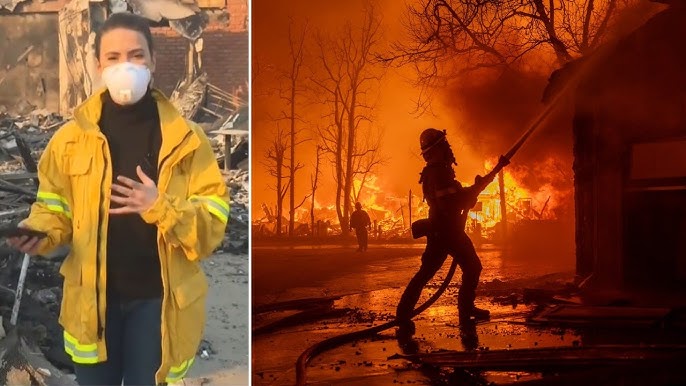Massive fires blaze through the Los Angeles area, blanketing neighborhoods with smoke and forcing thousands to evacuate their homes, while air quality remains unhealthy across many parts of the county.
Wildfire smoke consists of water vapor, gases, and microscopic particles called particulate matter. The smallest particles, known as PM2.5 due to their diameter of less than 2.5 micrometers, pose the greatest risk to human health. These particles can lodge deep in the lungs and sometimes enter the bloodstream. Earlier this week, PM2.5 levels around Los Angeles reached “hazardous” status, the highest warning on the US Air Quality Index.
“Wildfire smoke poses a risk to everyone, especially when large quantities of particulate matter are released over extended periods, as is currently happening in California,” says Zachary Rubin, a Chicago-area pediatric allergist and spokesperson for the American College of Allergy, Asthma, and Immunology.
When fine particulate matter is inhaled, it triggers inflammation in the body. Symptoms can range from mild—such as burning or itchy eyes, runny nose, scratchy throat, and headache—to severe respiratory issues, including difficulty breathing, wheezing, coughing, fatigue, and chest pain. Symptoms may appear within hours or take days after exposure. In the most severe cases, it increases the risk of premature death.
Children, older adults, pregnant individuals, and those with heart or lung conditions or weakened immune systems are at higher risk of severe side effects. However, Zachary Rubin, a Chicago-area pediatric allergist and spokesperson for the American College of Allergy, Asthma, and Immunology, warns that anyone, regardless of health status, can experience respiratory effects from wildfire smoke.
“Any level of air pollution, including from wildfires, can be dangerous to your health,” says Laura Corlin, an environmental epidemiologist at Tufts University School of Medicine. The level of danger depends on several factors, including your existing health condition, proximity to the fire, and length of exposure. “A good rule of thumb is that more exposure is worse,” she adds.
The composition of wildfire smoke also impacts health. In California, where fires are engulfing homes and businesses, the smoke likely contains chemicals released from synthetic building materials, which are more toxic than emissions from burning vegetation.
Residents in Los Angeles County and across the US can check airnow.gov for current air quality information in their area. Because air quality can change rapidly during a fire, regular monitoring is essential. Limiting exposure to outdoor air when quality is poor is recommended. Additionally, the Watch Duty app is a helpful tool for tracking nearby fires.
Protecting Yourself and Others
“The lungs filter the air we breathe and deliver it to the heart, which then pumps it throughout the body,” explains Shazia Jamil, a pulmonologist and professor of medicine at the Scripps Clinic and the University of California, San Diego. Jamil contributed to developing a guide for the American Thoracic Society on staying healthy during wildfires.
She notes that inhaling smoke can cause shortness of breath, wheezing, or an elevated respiratory rate, which increases heart rate and can worsen existing heart conditions. Even individuals in good health may experience chest pain and shortness of breath from smoke exposure.
Health officials in Los Angeles County urge everyone in areas with unhealthy air quality to stay indoors as much as possible. They also recommend limiting exercise and physical exertion, even indoors. “Strenuous physical activity causes deeper and faster breathing,” says Shazia Jamil. Combined with air pollution, this can lead to breathing problems.
When indoors, close windows and doors. Use wet towels to seal any cracks. Avoid air conditioners that only bring in outside air without recirculating it. Air purifiers with HEPA (high-efficiency particulate air) filters can help reduce fine particles indoors. Refrain from using fireplaces, candles, vacuums, gas stoves, and aerosols, as they emit fine particles that worsen indoor air quality.
If going outside is unavoidable, experts recommend wearing an N95 or P100 mask, which blocks 95% or more of small particles. Bandanas and cloth masks do not protect against wildfire smoke. While traveling in a car, reduce smoke exposure by keeping windows closed, running the air conditioner, and setting it to recirculate.
Although particulate matter can affect healthy individuals, it poses the greatest risk to those with asthma or chronic obstructive pulmonary disease (COPD). Fine particles travel into the lungs’ small airways, worsening these conditions. People with asthma or COPD should use their prescribed inhalers and medications as directed.
Babies and children are particularly vulnerable because their lungs are still developing. Older adults, especially those over 65, face added risks due to natural declines in lung function. Wildfire smoke also aggravates heart conditions, putting these groups at higher risk.
Be Cautious of Lingering Threats
Even after the initial blaze has passed or been extinguished, wildfire smoke continues to pose health risks. A 2023 study found that even after air purifiers initially clean the air, wildfire smoke can cling to surfaces like carpets, drapes, and countertops, prolonging exposure for those inside. Simple cleaning tasks such as vacuuming, dusting, and mopping can reduce exposure and limit risk.
In the coming days and weeks, people outside the Los Angeles area may also face smoke-related health risks. Wildfire smoke can travel hundreds of miles through the atmosphere. During the record-setting 2023 wildfires in Western Canada, smoke reached parts of the Eastern United States, including New York City and Philadelphia. “Smoke winds can travel over surprisingly long distances and time periods,” says Corlin.
That smoke can cause health problems even hundreds of miles away from the fire itself. A December study by researchers at the University of Maryland found that medical visits for heart and lung problems rose by nearly 20 percent during six days in June 2023, when smoke from the Western Canadian wildfires drifted across the country, leading to poor air quality in Baltimore and the surrounding region.



 Viesearch - The Human-curated Search Engine
Blogarama - Blog Directory
Web Directory gma
Directory Master
http://tech.ellysdirectory.com
Viesearch - The Human-curated Search Engine
Blogarama - Blog Directory
Web Directory gma
Directory Master
http://tech.ellysdirectory.com